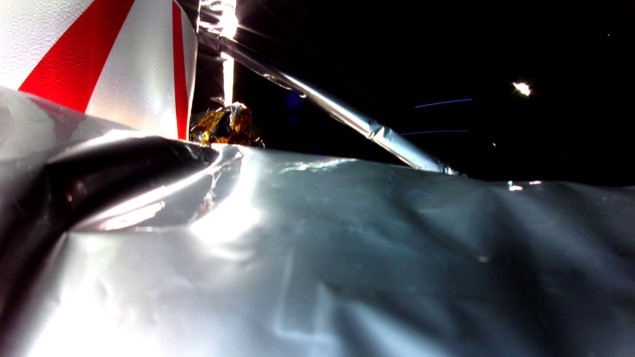US Peregrine lunar lander suffers propellant leak following launch
12 Jan 2024
Lunar bound: the first image taken by Astrobotic Technology’s Peregrine lunar lander shows damage to the craft’s body (courtesy: Astrobotic)
A US firm has announced that its Moon mission will not successfully land on the lunar surface after its fuel tank ruptured and began to leak propellent shortly after launch. The robotic landing craft, called Peregrine and owned by the private firm Astrobotic Technology, was launched on 8 January from Cape Canaveral, Florida, by a Vulcan Centaur rocket. Peregrine was set to be the first US spacecraft to land on the Moon since the Apollo programme.
Shortly after what seemed to be a successful launch, Astrobotic reported a failure in the probe’s propulsion system that sent it into an “uncontrollable tumble.”Mission controllers then managed to align the craft to charge its solar panels and it began taking data as it made its way to the Moon.
Yet on Wednesday the firm gave up hope that it could make a soft landing on the Moon, which would have been attempted on 23 February. Peregrine carries five NASA payloads, worth $108m.
Astrobotic Technology says that the failure was caused due to a valve that failed to reseal. This caused a rush of high-pressure helium into the fuel tank, which led to an increase in pressure “beyond its operating limit and subsequently ruptured the tank”. Astrobotic adds that it has “no indication that the propulsion anomaly occurred as a result of the launch”.
Peregrine’s demise casts a shadow on the Commercial Lunar Payloads Services (CLPS) programme. A partnership between NASA and 14 aerospace companies, many of them small and relatively new, CLPS aims to ferry NASA payloads to the Moon.
Another CLPS launch, involving a spacecraft built by Houston company Intuitive Machines, is scheduled for launch in the coming months. The programme also calls for Astrobotic to deliver a payload that will include ice-drilling equipment to the lunar south pole.
“We will use this lesson to propel our efforts to advance science, exploration and commercial development of the Moon,” noted Joel Kearns, NASA’s deputy associate administrator for exploration, in a statement.
Lunar woes
The incident represents another failed attempt over the past year to land a craft on the Moon. In April 2023 the Japanese firm ispace announced that its Hakuto-R Mission 1 craft failed to soft land on the Moon, while in August 2023 Russia’s uncrewed Luna-25 craft crashed into the lunar surface after spinning out of control. India’s Vikram lander, however, did make a successful soft landing on the Moon on 23 August.READ MORE

Peregrine’s woes came as NASA announced on 9 January that it will delay its Artemis II mission, a circumlunar flight of four astronauts that was originally scheduled for later this year. The agency now plans to launch Artemis II in September 2025 while Artemis III, which will land astronauts near the Moon’s south pole, has been shifted back from 2025 to September 2026.
However, the schedule for Artemis IV, the first mission to the Gateway lunar-orbiting space station, remains unchanged at some time in 2028. “We will use the Artemis II flight test, and each flight that follows, to reduce the risk for future Moon missions,” says Catherine Koerner, NASA associate administrator for exploration systems development. “We are closer than ever to establishing sustained exploration of Earth’s nearest neighbour under Artemis.”
Peter Gwynne is Physics World’s North America correspondent.
FROM PHYSICSWORLD.COM 14/01/2024

Δεν υπάρχουν σχόλια:
Δημοσίευση σχολίου